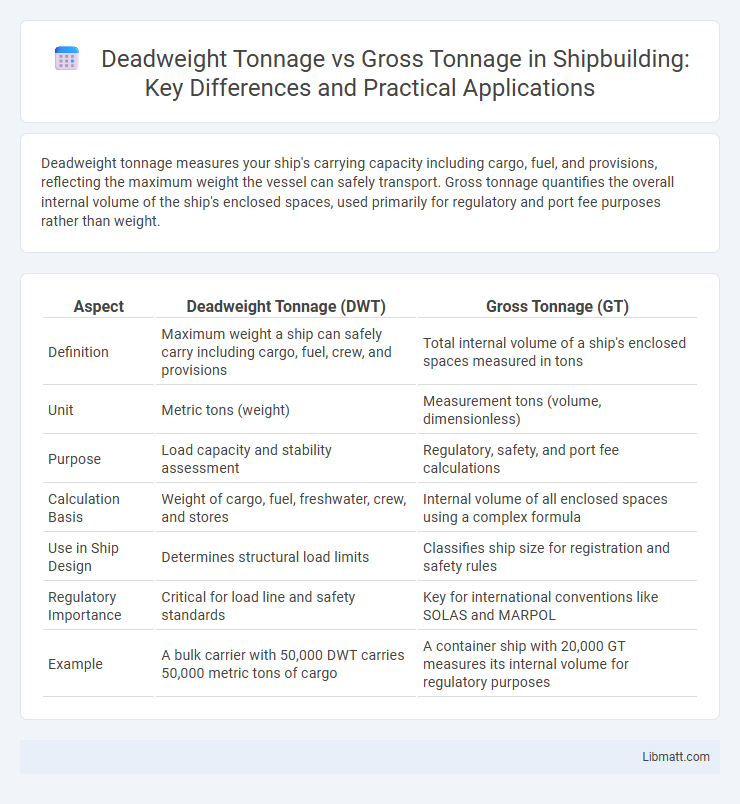Deadweight tonnage measures your ship's carrying capacity including cargo, fuel, and provisions, reflecting the maximum weight the vessel can safely transport. Gross tonnage quantifies the overall internal volume of the ship's enclosed spaces, used primarily for regulatory and port fee purposes rather than weight.
Table of Comparison
| Aspect | Deadweight Tonnage (DWT) | Gross Tonnage (GT) |
|---|---|---|
| Definition | Maximum weight a ship can safely carry including cargo, fuel, crew, and provisions | Total internal volume of a ship's enclosed spaces measured in tons |
| Unit | Metric tons (weight) | Measurement tons (volume, dimensionless) |
| Purpose | Load capacity and stability assessment | Regulatory, safety, and port fee calculations |
| Calculation Basis | Weight of cargo, fuel, freshwater, crew, and stores | Internal volume of all enclosed spaces using a complex formula |
| Use in Ship Design | Determines structural load limits | Classifies ship size for registration and safety rules |
| Regulatory Importance | Critical for load line and safety standards | Key for international conventions like SOLAS and MARPOL |
| Example | A bulk carrier with 50,000 DWT carries 50,000 metric tons of cargo | A container ship with 20,000 GT measures its internal volume for regulatory purposes |
Introduction to Ship Tonnage Measurements
Deadweight tonnage (DWT) measures the maximum weight a ship can safely carry, including cargo, fuel, passengers, and crew, while gross tonnage (GT) quantifies the total internal volume of a vessel's enclosed spaces. These measurements are essential for assessing a ship's capacity and determining port fees, safety regulations, and operational limits. Understanding the difference can help you better evaluate a ship's functionality and compliance within maritime industries.
Definition of Deadweight Tonnage (DWT)
Deadweight Tonnage (DWT) measures the maximum weight a ship can safely carry, including cargo, fuel, passengers, crew, and provisions, without exceeding its load line. It does not account for the ship's own weight, which is excluded from DWT calculations. This metric is crucial for determining a vessel's cargo-carrying capacity and operational limits.
Definition of Gross Tonnage (GT)
Gross Tonnage (GT) is a measurement of a ship's total internal volume, expressed in units that reflect the overall enclosed spaces available for cargo, passengers, and crew. Unlike Deadweight Tonnage, which indicates the maximum weight a vessel can safely carry, GT is a dimensionless index calculated using the molded volume of all enclosed spaces in cubic meters multiplied by a specific coefficient. This measure is crucial for regulatory, safety, and port fee determinations, providing a standardized method to assess the ship's size rather than its weight-carrying capacity.
Key Differences Between DWT and GT
Deadweight tonnage (DWT) measures the maximum weight a ship can safely carry, including cargo, fuel, crew, and provisions, whereas gross tonnage (GT) represents the total internal volume of the vessel's enclosed spaces, calculated based on a formula without direct reference to weight. DWT is expressed in metric tons and indicates the ship's carrying capacity, while GT is a dimensionless index used for regulatory, safety, and fee assessment purposes. Understanding these distinctions helps you evaluate a ship's operational limits versus its overall size and regulatory classification.
How Deadweight Tonnage is Calculated
Deadweight Tonnage (DWT) is calculated by measuring the total weight a vessel can safely carry, including cargo, fuel, passengers, crew, and provisions, without exceeding the ship's maximum safe draft. It is derived from the difference between a ship's loaded displacement and its lightweight (empty ship weight), both measured in metric tons. Understanding your ship's DWT helps ensure operational safety and compliance with maritime loading regulations.
How Gross Tonnage is Calculated
Gross Tonnage (GT) is calculated based on the total internal volume of a ship's enclosed spaces, measured in cubic meters, using the formula GT = K x V, where V is the volume and K is a constant derived from the logarithmic function of V. This measurement does not account for weight but reflects the ship's overall size, including cargo holds and machinery spaces. Compared to Deadweight Tonnage (DWT), which measures the vessel's carrying capacity in weight, Gross Tonnage serves primarily for regulatory and port fee purposes.
Importance of DWT in Shipping Operations
Deadweight tonnage (DWT) is critical in shipping operations as it quantifies the maximum weight a vessel can safely carry, including cargo, fuel, provisions, and crew, directly impacting loading efficiency and operational safety. Unlike gross tonnage, which measures the ship's overall internal volume for regulatory and fee purposes, DWT ensures compliance with international maritime safety standards by preventing overloading. Accurate DWT management optimizes fuel consumption, route planning, and port logistics, ultimately enhancing maritime transport profitability and environment sustainability.
Significance of GT in Regulatory Compliance
Gross Tonnage (GT) is a critical measurement used in regulatory compliance to determine a vessel's size for international maritime laws, safety regulations, and port fees. Unlike Deadweight Tonnage (DWT), which measures cargo-carrying capacity, GT influences your vessel's adherence to rules such as SOLAS and MARPOL conventions. Understanding GT ensures you meet mandatory inspections, crew certifications, and environmental requirements essential for global shipping operations.
Practical Applications: DWT vs GT in Vessel Classification
Deadweight tonnage (DWT) measures a vessel's carrying capacity including cargo, fuel, and provisions, making it critical for operational planning and safety compliance. Gross tonnage (GT) quantifies the ship's overall internal volume, influencing regulations such as port fees, manning requirements, and safety standards. Practical applications use DWT primarily for commercial cargo operations and load limits, while GT drives classification for regulatory compliance and port logistics.
Summary: Choosing the Right Tonnage Metric
Deadweight tonnage (DWT) measures a vessel's maximum carrying capacity including cargo, fuel, provisions, and crew, essential for operational and safety planning. Gross tonnage (GT) represents the ship's total internal volume, crucial for regulatory, port fees, and taxation purposes. Selecting the appropriate tonnage metric depends on whether cargo capacity or ship size and regulatory compliance is the priority.
Deadweight tonnage vs gross tonnage Infographic

 libmatt.com
libmatt.com